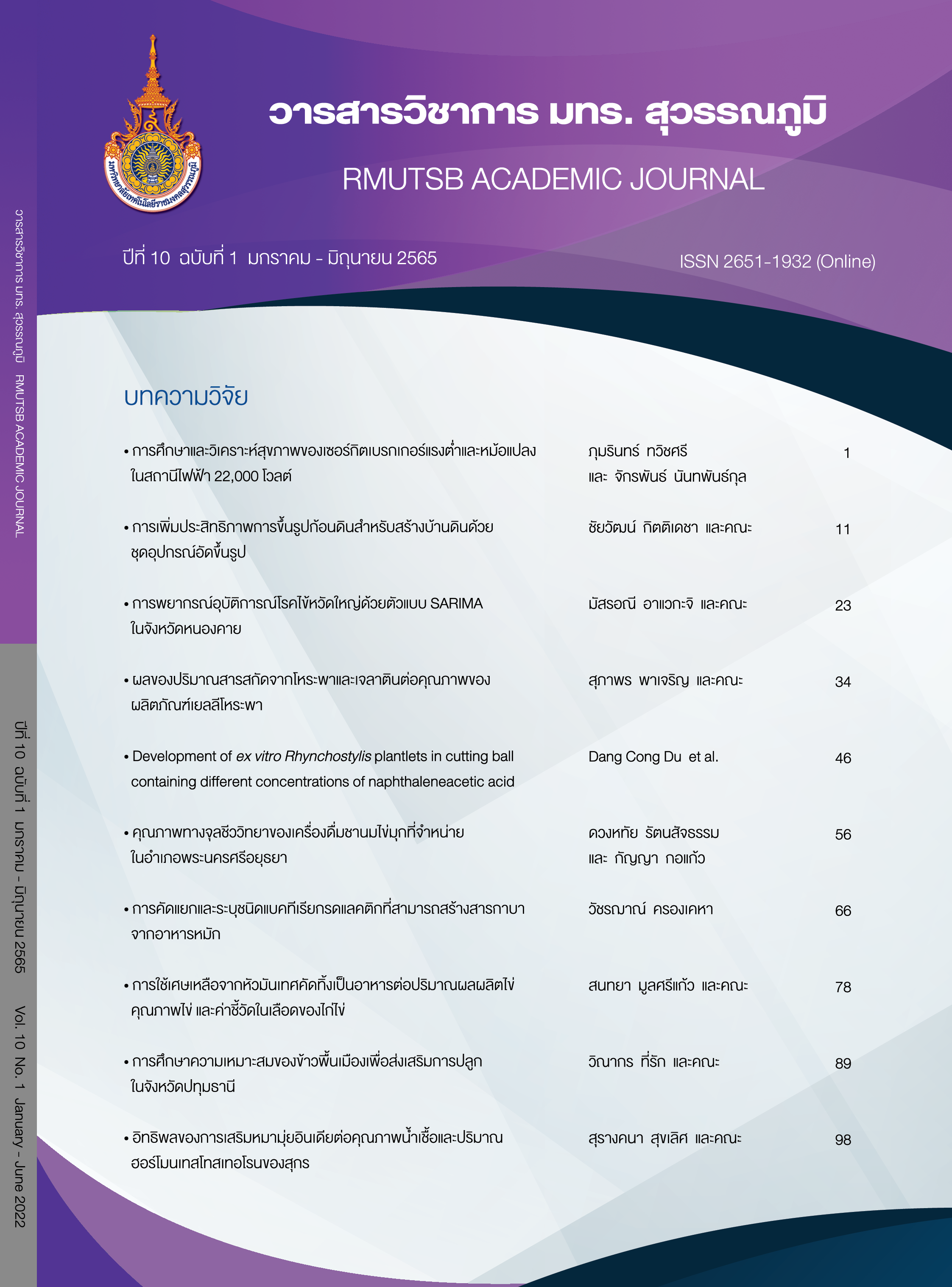Forecasting influenza incidence by SARIMA model in Nong Khai Province
Main Article Content
Abstract
The aims of this study were to determine the suitable model for forecasting the influenza incidence in Nong Khai province by using the monthly influenza data from 2016 to 2019. The Akaike’s Information Criteria (AIC), Bayesian Information Criteria (BIC), Root Mean Square Error (RMSE) and Mean Absolute Percentage Error (MAPE) were used to determine the efficient of the suitable model. The results were showed that the best model for forecasting influenza incidence was SARIMA (0,1,0)(2,1,0)12, providing the lowest AIC (102.37), BIC (107.04) with the RMSE value of 0.65 and MAPE value of 8.30%. It was indicated that SARIMA (0,1,0)(2,1,0)12 could be used to predict the influenza incidence in the future. The forecast information could be used to plan the influenza prevention and control, including the surveillance system for the area.
Article Details

This work is licensed under a Creative Commons Attribution-NonCommercial-NoDerivatives 4.0 International License.
Published manuscript are the rights of their original owners and RMUTSB Academic Journal. The manuscript content belongs to the authors' idea, it is not the opinion of the journal's committee and not the responsibility of Rajamangala University of Technology Suvarnabhumi
References
Chen, R. J. C., Bloomfield, P., & Fu, J. (2003). An evaluation of alternative forecasting methods to recreation site use. Journal of Leisure Research, 35(4), 441-454.
Chong, K. C., Lee, T. C., Bialasiewicz, S., Chen, J., Smith, D. W., Choy, W. S. C., Krajden, M., Jalal, H., Jennings, L., Alexander, B., Lee, H. K., Fraaij, P., Levy, A., Yeung, A. C. M., Tozer, S., Lau, S. Y. F., Jia , K. M. Tang, J. W. T., & Chan, P. K. S. (2020). Association between meteorological variations and activities of influenza A and B across different climate zones: a multi-region modelling analysis across the globe. Journal of Infection, 80(1), 84-98.
Chumkiew, S., Srisang, W., Jaroensutasinee, M., & Jaroensutasinee, K. (2007). Climatic affecting on influenza cases in Nakhon Sithammarat. International Journal of Medical and Health Sciences, 1(12), 626-629.
He, Z., & Tao, H. (2018). Epidemiology and ARIMA model of positive-rate of influenza viruses among children in Wuhan, China: A nine-year retrospective study. International Journal of Infectious Diseases, 74, 61-70.
Inthong, K., & Vorarat, S. (2013). A forecasting system for optimal sales objectives a case study fiber cement product. DPU Graduate Studies Journal, 2(2), 1269-1278. (in Thai)
Kiertiburanakul, S., Phongsamart, W., Tantawichien, T., Manosuthi, W., & Kulchaitanaroaj, P. (2020). Economic burden of influenza in Thailand: A systematic review. Inquiry: a journal of medical care organization, provision and financing, 57, 1-14.
Ministry of Public Health. Department of Disease Control, (2016). Annual epidemiology surveillance report 2016. Retrieved 14 December 2020, from https://apps-doe.moph.go.th/boeeng/annual/AESR2016/static/documents/highlight_sum.pdf (in Thai)
Ministry of Public Health, Department of Disease Control, (2017). Annual epidemiology surveillance report 2017. Retrieved 14 December 2020, from https://apps-doe.moph.go.th/boeeng/download/AESR-6112-24.pdf (in Thai)
Ministry of Public Health. Department of Disease Control. (2018). Annual epidemiology surveillance report 2018. Retrieved 14 December 2020, from https://apps-doe.moph.go.th/boeeng/download/AW_Annual_Mix%206212_14_r1.pdf (in Thai)
Sanguanrungsirikul, D., Chiewanantavanich, H., & Sangkasem, M. (2015) A comparative study to determine optimal models for forecasting the number of patients having epidemiological-surveillance diseases in Bangkok. KMUTT Research and Development Journal, 38(1), 35-55. (in Thai)
Simmerman, J. M., Malinee, C., Levy, J., Chantra, S., Maloney, S., Uyeki, T., Areerat, P., Thamthitiwat, S., Olsen, S. J., Fry, A., Ungchusak, K., Baggett, H. C., & Chunsuttiwat, S. (2009). Incidence, seasonality and mortality associated with influenza pneumonia in Thailand: 2005–2008. PloS one, 4(11), 1-8.
Song, X., Xiao, J., Deng, J., Kang, Q., Zhang, Y., & Xu, J. (2016). Time series analysis of influenza incidence in Chinese provinces from 2004 to 2011. Medicine, 95(26), 1-7.
Suntronwong, N., Thongpan, I., Chuchaona, W., Lestari, F. B., Vichaiwattana, P., Yorsaeng, R., Pasittungkul, S., Kitphati, R., Vongpunsawad, S., & Poovorawan, Y. (2020). Impact of COVID-19 public health interventions on influenza incidence in Thailand. Pathogens and Global Health, 114(5), 225-227.
Sutthichaimethee, J. (2011). Application of ARIMA model for research. Suthiparithat Journal, 25(76), 101-120. (in Thai)
Tanyarattanasrisakul, M. (2018). The accuracy comparison of time series model between Winters’ exponential smoothing and Box - Jenkins methods: A case study of forecasting garden coconut price. RMUTSB Academic Journal, 6(2), 101-113. (in Thai)
Tanyarattanasrisakul, M. (2019). A comparison of forecasting methods between Winters’ multiplicative exponential smoothing, Box-Jenkins, and combined methods, for forecasting monthly prices of white shrimp Litopenaeus vannamei. RMUTSB Academic Journal, 7(1), 72-86. (in Thai)
The Center for Food Security and Public Health. (2019). Influenza. Retrieved 16 December 2020, from http://www.
cfsph.iastate.edu/DiseaseInfo/disease.php?name=influenza&lang=en
The R Foundation. (2020). The R project for statistical computing. Retrieved 16 December 2020, from https://www.r-project.org/
World Health Organization. (2018). Influenza (seasonal). Retrieved 16 December 2020, from https://www.who.int/news-room/fact-sheets/detail/influenza-(seasonal)
World Health Organization. (2019). Global influenza strategy 2019–2030. Retrieved 16 December 2020, from https://www.who.int/publications/i/item/9789241515320
Wang, S., Feng, J., & Liu, G. (2013). Application of seasonal time series model in the precipitation forecast. Mathematical and Computer Modeling, 58(3), 677-683.
Zhu, G., Li, L., Zheng, Y., Zhang, X., & Zou, H. (2021). Forecasting influenza based on autoregressive moving average and Holt-Winters exponential smoothing models. Journal of Advanced Computational Intelligence and Intelligent Informatics, 25(1), 138-144.

